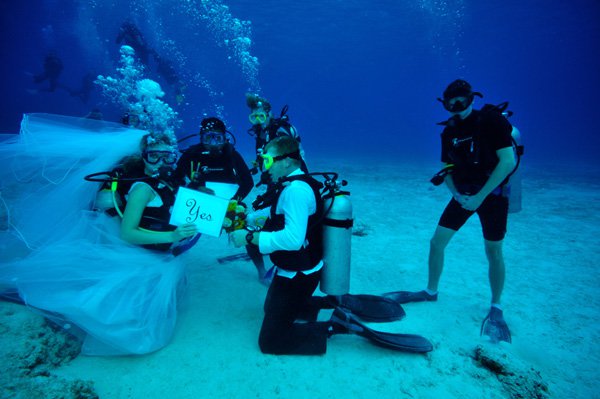Scuba Diving Molokai - Fish Rain
Overall Rating = 4.1 out of 5
Fish Rain is a great scuba diving site and probably has one of the highest densities of marine species that you will find while scuba diving in Maui County. This dive site would rate even higher if it was easier to access. Scuba diving in Molokai is challenging, this is not a dive for the novice. In fact any time you have to cross the Pailolo Channel you are in for an interesting ride. Seas can regularly be between 6 and 10 feet with strong gust or steady winds. The Pailolo Channel is one of the windiest and roughest of the Hawaiian Island channels. Seas of 4 to 6 feet should be considered calm water and it takes about 45 minutes to get to the dive site. So do not attempt this dive unless you do not have a problem with motion sickness, you are not intimidated by rough seas, and you are not concerned about exiting or reentering the boat while it is moving. But.... what a great dive.
Access - Difficult to reach the site; Complex entry and exit; Advanced level only
Depth to 120ft
Visibility - very good to excellent
Current - variable - moderate to quite strong
Marine Species variety - Wonderful diversity and high number of species; large pelagic species
Reef health - Very good
There are no buoys on the north east side of Molokai, no place for a boat to tie up and the high seas mean the boats must stay in constant motion when dropping or picking up divers. There will be rigid instructions given for entry and reentry into the boat and these must be followed. The dive masters and captains regularly take ginger before making this trip. So again, this trip is not for novice divers.
Now�.to the good stuff�.
Fish Rain is a really cool scuba diving site. It is on the far eastern side of Molokai near Mokuhooniki Rock. You go to this site for Hammerheads and you get the bonus of amazing diversity and quantity of marine life. The site depth is to about 110 feet around the pinnacle / Mokuhooniki Rock and there are sea grass beds along the bottom. You will a good amount of coral on the lava slopes of the pinnacle and such a great variety of fish surrounding that will make you think it is literally "raining" fish, hence the name of this site. If the weather is good and there is adequate sunlight this site makes a really nice place for underwater photography and the opportunity to see large pelagic species. If you do not encounter sharks or other pelagic species, do not worry this dive site will not disappoint.
You will need to exit the boat as it is moving. The seas are typically 2 to 4 feet as you enter the water. You will be given precise instructions on how to get into a ready position for entry into the water and you need to follow these closely. You will typically gear up and wait at your station until signaled by your dive master. You will then queue up in groups and when the dive master says "Dive, Dive, Dive" you enter the water, whith your camera or other gear and swim quickly away from the boat as all divers in yourgroup will be entering one right after the other. Your inner "navy seal" will love this. So enjoy.
Once in the water you will descend as a group quickly as you do not want to stay on the surface here for an extended period of time. As you descend you will notice immediately the large number of fish surrounding you and the pinnacle. You will see hundreds of fish including various Butterflyfishes such as the Pennant Butterflyfish and Milletseed Butterflyfish. You will also see Eels, Unicornfishes, all types of Wrasses and much more. A camera of some type is a must for this location if you can. The lava pinnacle has lots of very healthy hard corals covering the slope down to the sea floor which tends to be covered in sea grass. You will more than likely go to around 100 to 115 feet just off the pinnacle on your first dive and "hang out" waiting to for the Hammerhead sharks. You will more than likely at least get a view of the sharks in the distance and if you are patient and do not frighten them away they may come in to investigate your dive group. The Hammerheads are easily frightened or chased away so do not chase them as soon as you see them. Be patient and wait for them to approach your group, they are basically curious and you may be rewarded to see them up close.
This is more or less a drift dive and you will follow your instructor and then surface and wait forthe boat to come and pick you up. You must have a safety sausage or signaling device when on this dive. It is extremely difficult to see a diver in calm waters from a distance and in these seas without a signaling device you can easily be missed. When you surface, have one or more of the people in your group inflate their safety sausage and then wait until the ship spots you. You could be on the surface for 15 minutes before you are picked up, especially if you have more than one group in the water. The boat will typically have a line in the water and all divers will need to use the rope for reentry. As the boat comes by simply grab and hold onto the line and then wait your turn to approach and enter the boat. Be prepared and be patient. This is certainly one of my favorite scuba diving sites and highly recommended to very experienced divers.
View other underwater photography images on my website or visit my blog or follow me on Twitter @ images2inspire. The pool is open...
Scuba Diving Maui - Black Rock
Scuba Diving Grand Cayman - Lonestar Ledges


